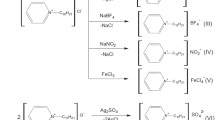Abstract
A series of 4-amino-1-alkyl pyridinium bromide salts (1–10) were synthesized and antimicrobial activity was evaluated by disc diffusion as well as broth macro-dilution method. 4-Amino-1-hexadecylpyridinium bromide (10) which showed good inhibition against Candida albicans and C. glabrata also displayed good germ tube inhibition against C. albicans. Compound 8 shows very low haemolytic activity against human red blood cells. Compound 10 exhibits excellent antibacterial activity against Escherichia coli and Staphylococcus aureus. Inhibition of phospholipase enzyme secretion was also observed against compound 8 to find the possible mode of action.




Similar content being viewed by others
References
Bauer AW, Kirby WMM, Sherris JC, Turok M (1966) Antibiotic susceptibility testing by a standardized single disk method. Am J Clin Pathol 45:493–496
Christoph T, Thorsten M, Matthias K (2010) Synthesis of 3-Alkyl pyridinium alkaloids from the arctic sponge Haliclona viscose. Mar Drugs 8:483–497
Ellepola AN, Samaranayake LP (1998) The effect of limited exposure to antifungal agents on the germ tube formation of oral Candida albicans. J Oral Pathol Med 27:213–219
Kadir T, Gumru B, Uygun-Can B (2007) Phospholipase activity of Candida albicans isolates from patients with denture stomatitis: the influence of chlorhexidine gluconate on phospholipase production. Arch Oral Biol 52:691–696
Kas’yan LI, Tarabara IN, Pal’chikov VA, Krishchik OV, Isaev AK, Kasyan AO (2005) Acylation of aminopyridines and related compounds with Endic anhydride. Russ J Org Chem 41:1530–1538
Madaan P, Tyagi VK (2008) Synthesis and characterization of the antimicrobial 4-amino-decyl pyridinium bromide cationic surfactant. Surf Rev Lett 15:531–536
Maeda T, Okazaki K, Nagamune H, Manabe Y, Kourai H (1998) Bactericidal Action of 4,4′-(α,ω-Polymethylenedithio)bis-(1-alkyl pyridinium iodide)s. Biol Pharm Bull 21:1057–1061
Maeda T, Manabe Y, Yamamoto M, Yoshida M, Okazaki K, Nagamune H, Hiroki K (1999) Synthesis and antimicrobial characteristics of novel biocides, 4,4′-(1,6-Hexamethylene dioxydicarbonyl) bis(1-alkyl pyridinium iodide)s. Chem Pharm Bull 47:1020–1023
Mark C, Donglai Y, Klaus K, Adelbert B (2001) Design, synthesis, and evaluation of 9-D-Ribityl-1, 3, 7-trihydro-2, 6, 8-purinetrione, a potent Inhibitor of riboflavin synthase and lumazine synthase. J Org Chem 66:8320–8327
Morgunova E, Saller S, Hasse I, Cushman M, Bacher A, Fischer M, Ladenstein R (2007) Synthase from Candida albicans as an anti-fungal target enzyme structural and biochemical basis for drug Design. J Biol Chem 282:17231–17241
National Committee for Clinical Laboratory Standards (NCCLS) (1997) Approved standard M27-A. Reference methods for broth dilution antifungal susceptibility testing of yeasts, NCCLS, Wayne, PA
National Committee for Clinical Laboratory Standards (NCCLS) (2001) Methods for dilution antimicrobial susceptibility tests for bacteria that grow aerobically; approved standard, 5th edn. NCCLS document M7-A5 (ISBN 1-56238-394-9), NCCLS, Wayne, PA
Ng CKL, Daniel O, Widmer F, Wright LC, Sorrell TC, Jolliffe KAJ (2006) Correlation of antifungal activity with fungal phospholipase inhibition using a series of bisquaternary ammonium salts. Med Chem 49:811–816
Ng CKL, Singhal V, Widmer F, Wright LC, Sorrell TC, Jolliffe KA (2007) Synthesis, antifungal and haemolytic activity of a series of bis(pyridinium)alkanes. Bioorg Med Chem 15:3422–3429
Obando D, Pantarat N, Handke R, Koda Y, Widmer F, Djordjevic JT, Ellis D, Sorrell TC, Jolliffe KA (2009) Synthesis, antifungal, haemolytic and cytotoxic activities of a series of bis(alkypyridinium)alkanes. Bioorg Med Chem 17:6329–6339
Okazaki K, Maeda T, Nagamune H, Manabe Y, Kourai H (1997) Synthesis and antimicrobial characteristics of 4, 4’-(α, ω-Polymethylenedithio)bis(1-alkyl pyridinium iodide)s. Chem Pharm Bull 45:1970–1974
Parag M, Vinod KT (2008) Quaternary pyridinium salts: a review. J Oleo Sci 57:197–215
Pillay MK, Jeyaraman R, Nallu M, Venuvanalingam P, Ramalingam M (1997) Kinetic and theoretical studies on the reaction of phenacyl bromide with 4dmap in the presence of certain phenols. Indian J Chem 36A:414–417
Runyoro KBD, Matee IM, Ngassapa DO, Joseph CC, Mbwambo ZH (2006) Screening of Tanzanian medicinal plants for anti-Candida activity. BMC Complement Altern Med 6:11
Samaranayake LP, Raeside JM, MacFarlane TW (1984) Factors affecting the phospholipase activity of Candida species in vitro. Sabouraudia 22:201–207
Seethalakshmi T, Venkatesan P, Butcher RJ, Nallu M, Kaliannan P (2006a) 1-Allyl-4-aminopyridinium bromide. Acta Cryst E62:o4730–o4731
Seethalakshmi T, Venkatesan P, Kaliannan P, Fronczek FR, Thamotharan S (2006b) 4-Amino -(1-ethoxycarbonylmethyl) pyridinium iodide. Acta Cryst E62:o2560–o2562
Sundar TV, Parthasarathi V, Sridhar B, Venkatesan P, Nallu M (2006) 2-Amino-1–(4-Nitrobenzyl) pyridinium bromide. Acta Cryst E62:o74–o76
Thorsteinsson T, Masson M, Kristinsson KG, Hjalmarsdottir MA, Hilmarsson H, Loftsson T (2003) Soft antimicrobial agents: synthesis and activity of labile environmentally friendly long chain quaternary ammonium compounds. J Med Chem 46:4173–4181
Vildan A, Sulunay P, Huseyin T, Ercin E (2009) Synthesis and antimicrobial activity of some pyridinium salts. Molecules 14:5203–5215
White TC, Marr KA, Bowden RA (1998) Clinical, cellular and molecular factors that contribute to antifungal drug resistance. Clin Microbiol Rev 11:382–402
Zhao T, Sun G (2006) Synthesis and characterization of antimicrobial cationic surfactants: aminopyridinium salts. J Surfactants Deterg 9:325–330
Zhao T, Sun G (2008) Hydrophobicity and antimicrobial activities of quaternary pyridinium salts. J Appl Microbiol 104:824–830
Acknowledgments
Authors thank Professor M. Nallu, for valuable suggestions and ideas and DST-India (FIST programme) for the use of 400 MHz NMR spectrometer at the School of Chemistry, Bharathidasan University.
Author information
Authors and Affiliations
Corresponding author
Rights and permissions
About this article
Cite this article
Ilangovan, A., Venkatesan, P., Sundararaman, M. et al. Synthesis, characterization and antimicrobial activity of 4-amino-1-alkyl pyridinium salts. Med Chem Res 21, 694–702 (2012). https://doi.org/10.1007/s00044-011-9578-4
Received:
Accepted:
Published:
Issue Date:
DOI: https://doi.org/10.1007/s00044-011-9578-4




